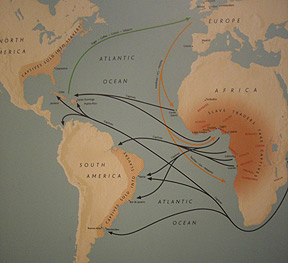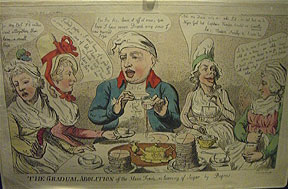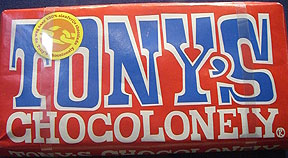November 19, 2007
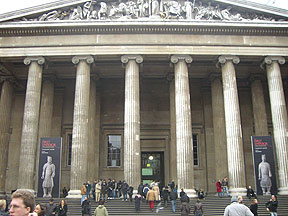 While organizing continues in Immokalee and around the country for the March on Burger King (due to start in less than a fortnight…), a team from the CIW arrived in London in preparation for the November 21st ceremony at which the CIW will be presented the 2007 Anti-Slavery Award by Anti-Slavery International (ASI). As part of the preparations, the CIW team visited the British Museum, a venerable institution that has housed some of the world’s most important art and antiquities since 1749. |
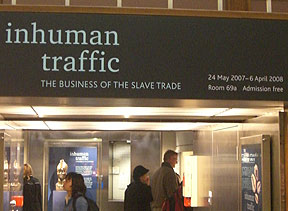 But on this occasion the museum was housing a new exhibit, a collection of artifacts from the horrific history of the Transatlantic Slave Trade, part of an exhibition that is actually taking place simultaneously in several museums and public spaces around London. But on this occasion the museum was housing a new exhibit, a collection of artifacts from the horrific history of the Transatlantic Slave Trade, part of an exhibition that is actually taking place simultaneously in several museums and public spaces around London. |
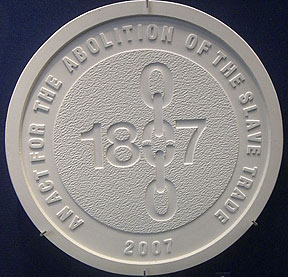 The exhibition is timed to coincide with remembrance of an important milestone in the fight against slavery — the 1807 passage of the Slave Trade Abolition Bill in the British Parliament. The medal above is the cast for a commemorative coin marking the bicentennial of the passage of that landmark bill. |
“The transatlantic slave trade is often known as the ‘triangular trade” — Europeans took goods to Africa and exchanged them for captives, who were taken to the Americas to work on plantations. The commodities produced there were taken back to Europe, then the cycle started again.” Starting in the mid-fifteenth century and continuing for more than four hundred years, Europeans enslaved millions of Africans through the transatlantic slave trade. Records show that over 12 million Africans were loaded onto slave ships during those four centuries and that over three million people died on those ships. According to British government records, “British ships made about 11,000 slaving voyages.” The plantations on which slaves toiled included many newly established farms in Florida. The companion exhibit at the National Gallery (where photos, unfortunately, are not allowed) draws the direct link to Florida’s fields, with a map from the 18th century of plantations along the state’s east coast in the area of what is present day Daytona Beach. |
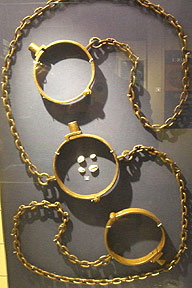 Some of the tools of the transatlantic slave trade were included in the British Museum’s exhibit… |
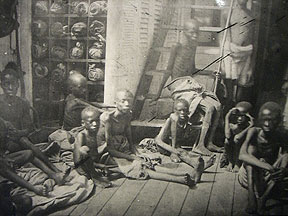 … along with rare, terrible photos, like this one taken of a voyage during the latter days of the trade. The exhibit made plain the barbarity of slavery in its rawest, most brutal form, a four-century long genocide that left enduring scars on everyone and everything it touched. |
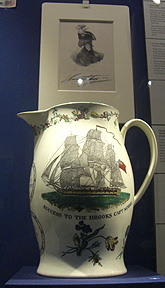 The exhibit underscored the deep contradictions that defined 18th century British culture — a society of great and growing wealth in England fed by the unconscionable exploitation of a slave-based economy in the colonies. This presentation captured the contradiction of the times: below, an ornate pitcher decorated in honor of a slave ship, the caption reading “Success to the Brooks Capt. Nobel”; above, a portrait of Toussaint L’ Ouverture, the fabled leader of Haiti’s revolution which resulted in the first successful slave-led overthrow of colonial control in the new world in 1804. |
“This satirical print shows the royal family taking tea. It makes fun of the reluctance of the upper classes to give up their sweet treats despite knowing how they were produced.” The boycott of slave-produced sugar was a key campaign in bringing about the passage of the Slave Trade Abolition Bill in 1807, as abolitionists joined forces with former slaves to educate British consumers about the conditions behind the sugar that sweetened their tea. |
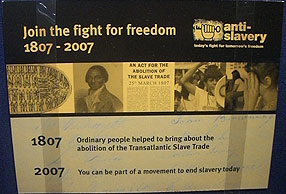 That campaign laid the foundations for what is today Anti-Slavery International, the oldest international human rights organization in the world and the CIW’s host in London. ASI is a leader in the fight against modern-day slavery, a fight that has drawn many lessons from the struggle to abolish the Transatlantic Slave Trade, including the importance of educating and engaging consumers in demanding that the products they consume be free of forced labor. |
“Tony’s Chocoloney Bar — Teun Van der Keuken (Tony) is a journalist and campaigner in the Netherlands. In response to reports of the use of forced child labour on cocoa plantations in West Africa, he started marketing his own brand of ‘slave-free’ chocolate. Chocolate companies are working towards ending the use of forced child labour by 2008.” On our side of the Atlantic, the CIW’s successful Taco Bell boycott established the first enforceable zero tolerance policy in the fast-food industry for modern-day slavery — men and women forced to work against their will, often held in debt-bondage, though violence or the threat or violence — in the fields where Taco Bell’s tomatoes are picked. The impact of that policy was expanded significantly by the agreement with McDonald’s in April of this year. But instead of prompting other fast-food companies to follow suit, the McDonald’s agreement appears to have provoked the Florida Tomato Growers’ Exchange (FTGE), a lobbying group for the state’s growers, to declare its refusal to allow its grower members to participate in the Taco Bell or McDonald’s agreements, a decision the FTGE made public shortly after the McDonald’s announcement and again in recent weeks. Since then, Burger King has cited the FTGE’s refusal to participate as one of the reasons why the second-largest burger company in the world will not work with the CIW to improve conditions in Florida’s fields. And so we march. And when it comes time for the boycott… Burger King’s executives would do well to remember that their company has many a restaurant in England, a country in the midst of a bicentennial celebration of the power of consumers and workers to demand an end to slavery. Check back Thursday for the photos and report from the 2007 Anti-Slavery Award ceremony! |

